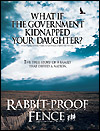| |

 AUSTRALIAN
"HALF-CASTES" DENIED RIGHTS ALONG THE RABBIT-PROOF
FENCE AUSTRALIAN
"HALF-CASTES" DENIED RIGHTS ALONG THE RABBIT-PROOF
FENCE
The longest fence in the world bisects Australia
for 1,500 miles. Farmland is on one side of the fence, which
thus serves to prevent rabbits from invading the crops; hence
the name "rabbit-proof fence." Building and maintaining
the fence placed some European settlers into contact with
the native population. In 1905, when Australia was under British
rule, a growing number of children from mixed European and
aboriginal ancestries challenged the "pure race"
ideology of the country. Accordingly, the authorities transferred
"half-caste" children, as they were called, to schools
where they could be taught skills that would enable them to
live in the "mainstream." (The catastrophic decline
of the native population, which numbered 60,000 in 1877 but
only 20,000 in 1937, encouraged the view that aboriginals
would eventually die out.) The practice was made a matter
of law, and the position of Chief Protector of the Aboriginals
was created. A. A. Neville (played by Kenneth Branagh), who
served in the role until his retirement in 1940, had the absolute
power to determine which "half-castes" would be
allowed to "graduate" from the schools in order
to play the role of servants for the dominant white settlers.
The film Rabbit-Proof Fence, directed
by Phillip Noyce, is the story of three girls, aged from 8
to 14, who objected to their forcible removal from their mother
in Jigalong to a training camp some 1,200 miles away at the
Moore River. When the film begins, the year is 1931. We see
young Molly Craig (played by Everlyn Sampi) as a particularly
able trapper. Her father, who worked on the fence, could not
take his wife into mainstream Australian society, so he left
his child under her mother's care.
|
One day, the authorities kidnap three children, including
Molly and her cousins Gracie (played by Laura Monaghan) and
Daisy (played by Tianna Sansbury). They are trucked to the
Moore River camp, assigned beds in a dorm with other "half-caste"
children, washed and scrubbed, and placed in a work environment
to learn a domestic skill. But they miss their mother. On
their second day of captivity, a girl of the camp who escaped
to see her boyfriend at a nearby camp for boys, is returned
by a trapper (played by David Gulpilil), an aboriginal employed
by the Chief Protector. The errant girl is then whipped with
a riding crop, her hair is cut off, and she is locked in a
solitary hut adjacent to the place where excrement is dumped.
Despite the obvious deterrent to future escapes, the three
girls decide to flee that day. Molly cleverly disguises their
path so that they cannot be tracked down, and they evade capture
for some three months, often with the help of white farmers.
A considerable portion of the film focuses on how they proceed
on foot through difficult terrain. Eventually, all three are
found and returned to the Moore River facility. Titles at
the end indicate that there was a second escape and return,
that the government finally abolished the practice of treating
mixed race children as wards of the state in 1970, and that
those victimized by the racist policy are called the "stolen
generations." At the end of the film, we see both Molly
and Daisy today, thus recognized on the screen for their heroism
in defying an injustice. Based on the book of the same title
by Molly's daughter, Rabbit-Proof Fence
has been nominated by the Political Film Society for two awards--best
film exposé and best film on human rights in 2002.
Nevertheless, the film has been controversial within Australia,
where much of the population was once schooled in a Social
Darwinist racist ideology that attempted to legitimate a policy
described by an official Australian government report in 1997
as "genocide." MH
|
|